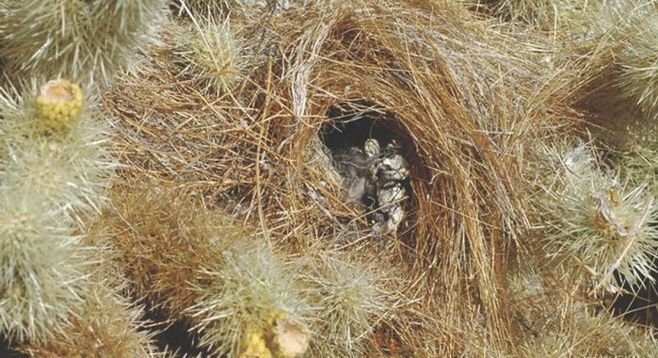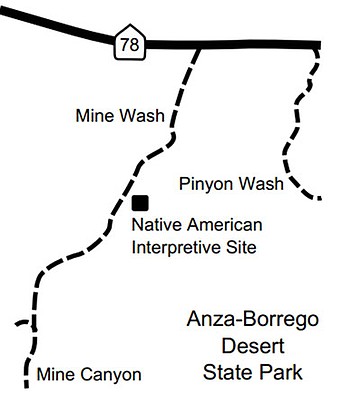 Facebook
Facebook
 X
X
 Instagram
Instagram
 TikTok
TikTok
 Youtube
Youtube

A major archaeological site, a treasure trove of fascinating plants and animals, and beautiful scenery ranging from wide-open desert views to narrow winding mountain canyons all await anyone who takes a drive and hike up Mine Wash and Canyon.
The first stop is the Kumeyaay village site peppered with morteros and metates on the granitic rock surrounded by agave roasting pits. The Kumeyaay, who traveled seasonally, harvesting plants from the coast, mountains, and desert areas, used pestles for pounding acorns and mesquite in mortero holes and manos (or smooth rocks) for grinding seeds and grains on metates or slicks. The heart of the Agave desertii had the sweet flavor of baked yams or pineapple after roasting in pits.
Note the scattered pottery shards in the village area but leave everything as is for others to enjoy. All cultural and natural features are protected by the state park and cannot be collected.
This area has an abundance of beautiful cholla cactus, including the famed “jumping cholla,” said to jump its prickly segments onto unsuspecting hikers who venture too close! Somehow this does not bother the cactus wren that sleeps safely at night protected by the cholla spines.
Return to your vehicle and drive another three miles, stopping at the end of the wash where Mine Canyon is located between Chuckwalla and Bighorn canyons in the Pinyon Mountains. The remains of an abandoned gold mine, for which the wash and canyon are named, is located on the northwest bank of the wash. The walk through the canyon is easy except for a vertical scramble of about four feet on igneous rock.
Look for phainopeplas, a black-crested bird with white outer wing patches, near acacias that have large growths of mistletoe. Also, look for black-throated sparrows near low-growing scrubs or cactus and for white-crowned sparrows, desert migrants from the coast that are easy to spot due to their white-striped heads.
Another interesting animal found here is the antlion. Look for miniature caves in the rock walls that collect wind-blown sand and house immature antlions identified by their funnel-shaped pits. The antlions wait at the bottom of the pit under cover of soft sand with only their mandibles exposed. Ants and other small insects slide to the bottom of the pit where antlions suck out their body fluids then fling the carcasses out and wait for the next meal.
This interesting insect has an incomplete digestive tract. Waste materials accumulate in the midgut, then are expelled near the end of the pupal stage after the anus is finally connected. The antlion life cycle is two to three years with the last remaining days spent as an adult that cannot eat. Adult antlions resemble a damselfly that has clubbed antennae, delicate when compared to the immature stage with a large hairy body and piercing mandibles.
Also found in the wash is jojoba, a plant native only in the Sonoran Desert. The seeds, or “beans,” contain oil, which in reality is a liquid wax, chemically resembling sperm whale oil. In the 1970s and 1980s jojoba, or Simmondsia chinensis, was planted in Southern California as a commercial crop. This was a financial gamble that was lost in many cases because only female plants produce seed. It can take over five years to discover if the young plants are male or female!

Visit a large Kumeyaay village site with grinding areas and hundreds of agave-roasting pits. Then continue after a short drive and by foot into the North Pinyon Mountains via Mine Wash.
Distance from downtown San Diego: 82 miles. Allow 2 hours’ driving time. (Anza-Borrego Desert State Park) From Julian, drive east past the junction of Hwy 78 and S3/Yaqui Pass Road (Tamarisk Grove intersection) for 2.7 miles turning south on Mine Wash. Continue off road for 1.6 miles to the Kumeyaay village then 3.1 miles past the village to Mine Canyon. High clearance vehicles are best driving through Mine Wash to the final destination at Mine Canyon.
Hiking length: Five miles total, returning on the same route
Difficulty: Easy with short scramble over slick rock; Elevation change up to 500 feet


A major archaeological site, a treasure trove of fascinating plants and animals, and beautiful scenery ranging from wide-open desert views to narrow winding mountain canyons all await anyone who takes a drive and hike up Mine Wash and Canyon.
The first stop is the Kumeyaay village site peppered with morteros and metates on the granitic rock surrounded by agave roasting pits. The Kumeyaay, who traveled seasonally, harvesting plants from the coast, mountains, and desert areas, used pestles for pounding acorns and mesquite in mortero holes and manos (or smooth rocks) for grinding seeds and grains on metates or slicks. The heart of the Agave desertii had the sweet flavor of baked yams or pineapple after roasting in pits.
Note the scattered pottery shards in the village area but leave everything as is for others to enjoy. All cultural and natural features are protected by the state park and cannot be collected.
This area has an abundance of beautiful cholla cactus, including the famed “jumping cholla,” said to jump its prickly segments onto unsuspecting hikers who venture too close! Somehow this does not bother the cactus wren that sleeps safely at night protected by the cholla spines.
Return to your vehicle and drive another three miles, stopping at the end of the wash where Mine Canyon is located between Chuckwalla and Bighorn canyons in the Pinyon Mountains. The remains of an abandoned gold mine, for which the wash and canyon are named, is located on the northwest bank of the wash. The walk through the canyon is easy except for a vertical scramble of about four feet on igneous rock.
Look for phainopeplas, a black-crested bird with white outer wing patches, near acacias that have large growths of mistletoe. Also, look for black-throated sparrows near low-growing scrubs or cactus and for white-crowned sparrows, desert migrants from the coast that are easy to spot due to their white-striped heads.
Another interesting animal found here is the antlion. Look for miniature caves in the rock walls that collect wind-blown sand and house immature antlions identified by their funnel-shaped pits. The antlions wait at the bottom of the pit under cover of soft sand with only their mandibles exposed. Ants and other small insects slide to the bottom of the pit where antlions suck out their body fluids then fling the carcasses out and wait for the next meal.
This interesting insect has an incomplete digestive tract. Waste materials accumulate in the midgut, then are expelled near the end of the pupal stage after the anus is finally connected. The antlion life cycle is two to three years with the last remaining days spent as an adult that cannot eat. Adult antlions resemble a damselfly that has clubbed antennae, delicate when compared to the immature stage with a large hairy body and piercing mandibles.
Also found in the wash is jojoba, a plant native only in the Sonoran Desert. The seeds, or “beans,” contain oil, which in reality is a liquid wax, chemically resembling sperm whale oil. In the 1970s and 1980s jojoba, or Simmondsia chinensis, was planted in Southern California as a commercial crop. This was a financial gamble that was lost in many cases because only female plants produce seed. It can take over five years to discover if the young plants are male or female!

Visit a large Kumeyaay village site with grinding areas and hundreds of agave-roasting pits. Then continue after a short drive and by foot into the North Pinyon Mountains via Mine Wash.
Distance from downtown San Diego: 82 miles. Allow 2 hours’ driving time. (Anza-Borrego Desert State Park) From Julian, drive east past the junction of Hwy 78 and S3/Yaqui Pass Road (Tamarisk Grove intersection) for 2.7 miles turning south on Mine Wash. Continue off road for 1.6 miles to the Kumeyaay village then 3.1 miles past the village to Mine Canyon. High clearance vehicles are best driving through Mine Wash to the final destination at Mine Canyon.
Hiking length: Five miles total, returning on the same route
Difficulty: Easy with short scramble over slick rock; Elevation change up to 500 feet
Comments